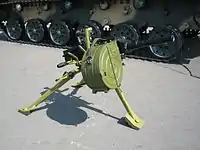Armed Forces of the Republic of Ivory Coast
The Armed Forces of Côte d'Ivoire (French: Forces Armées de Cote d'Ivoire; "FACI") are the armed forces of Ivory Coast.
| Armed Forces of Côte d'Ivoire | |
|---|---|
| Forces Armées de Cote d'Ivoire | |
.svg.png.webp) Republic of Ivory Coast Coat of arms | |
| Service branches |
|
| Leadership | |
| Commander-in-Chief | President Alassane Ouattara |
| Minister of Defense | Téné Birahima Ouattara |
| Chief of the Defence Staff | Army corps general Lassina Doumbia |
| Personnel | |
| Active personnel | 22,000 (estimate as of 2017) [1] |
| Expenditures | |
| Budget |
|
| Percent of GDP | 1.5% (fiscal year 2009) |
| Related articles | |
| History | |
| Ranks | Military ranks of Ivory Coast |
History
The Ivorian military has its roots in the colonial armed forces of French West Africa, which were headquartered in Dakar, Senegal but possessed bases in several distinct military regions. Most Ivorian recruits who joined the colonial army were assigned to Senegalese units during this period,[2] such as the Senegalese Tirailleurs. They served with distinction during both world wars, with 20,000 Ivorian soldiers fighting for the French during World War I and another 30,000 during World War II.[2] In 1950, the French government began the process of setting up a specific defence force for the colony, consisting of four infantry companies and a light armoured unit.[2]
The Ivory Coast became independent on 7 August 1960. In April 1961, the new government signed the Franco-Ivorian Technical Military Assistance Accord with France, which compelled the latter to assist with the formation of a new national military.[2] It also authorised the continued presence of French troops based in Port-Bouët, and permitted the government to call on French military assistance in the event of external aggression or major internal unrest.[3] By the end of 1962, the fledgling Ivorian armed forces had expanded rapidly into 5,000 soldiers attached to four battalions. Most of the initial recruits were drawn from the defunct colonial military establishment and had served in various French units, particularly the marine regiments.[2] They were armed with old equipment donated by France, including two Max Holste Broussard monoplanes, a single Douglas DC-3 cargo aircraft, fifteen M8 Greyhound armoured cars, and even a SC-497-class submarine chaser.[4] Conscription was instituted, although the large number of volunteers and low manpower requirements ensured it was only applied selectively.[2] Some of the senior positions in the officer corps and Ministry of Defence continued to be held by French nationals.[2]
Since the Ivory Coast could ill afford to divert funds from its economic development programmes into the armed forces, and was already dependent on France for its external defence, the military establishment remained quite modest from 1961 to 1974.[2] Defence spending spiralled upwards between 1974 and 1987, and the number of personnel serving with the armed forces increased to 14,920 men.[2] During this period, the air force and navy embarked on a significant modernisation campaign.[4] An international merchant marine training academy was built in Abidjan and trained personnel from several Economic Community of West African States (ECOWAS) governments.[2]
In 1997, a collapse in civil-military relations became evident when President Henri Konan Bédié dismissed popular general Robert Guéï on suspicion of disloyalty.[5] Two years later, an army mutiny led by disgruntled recruits and junior officers escalated into a major coup d'état which ousted Bédié and installed Guéï in his place.[5] Guéï subsequently stood for office during a subsequent presidential election, although he attempted to annul the election results when Laurent Gbagbo secured the popular vote.[6] This triggered a civil revolt in Abidjan and two days of street battles between Gbagbo supporters and soldiers loyal to Guéï.[6] Most of the armed forces remained neutral until the third day, when the army's elite units and the gendarmerie announced they would recognise Gbagbo as president of the republic.[6] Guéï conceded defeat, going into exile on October 29, 2000.[6]
In September 2002, the Ivory Coast endured a second army mutiny, this time by 750 Muslim soldiers who seized Bouaké, citing religious discrimination and grievances against the predominantly Christian government.[7] The mutineers later took control of most of the northern administrative regions, carrying out a brutal campaign of ethnic cleansing and plunging the country into civil war.[8] For a number of years, troops dispatched by France, ECOWAS, and a United Nations Operation in Côte d'Ivoire (ONUCI) effort enforced a buffer zone between the south and the rebel-held north.[8]

President Gbagbo repeatedly demanded France assist him in crushing the rebel forces.[9] France maintained it would not take sides in the civil war, but allowed Ivorian military aircraft to cross the buffer zone and attack rebel positions.[9] In November 2004, an Ivorian pilot targeted a French base during an air strike on Bouaké, killing nine French soldiers. The French retaliated by launching a follow-up operation to destroy the Ivorian Air Force.[9]
In March 2011, a rebel coalition, the Forces Nouvelles de Côte d'Ivoire, launched a renewed offensive on the south with French support, sparking a second civil war.[10] The Ivorian army was quickly overwhelmed, and Gbagbo deposed by the rebels.[10] The Forces Nouvelles established a new national military, known as the Republican Forces of Ivory Coast (FRCI).[10]
Integration problems arising from the incorporation of various rebel factions into the FRCI, as well as former Gbagbo loyalists, continue to persist.[11] In 2014, some army units launched an abortive mutiny over wage disputes. The crisis ended when the Ivorian political leadership agreed to a new financial settlement with the FRCI.[11] A second mutiny occurred on January 7, 2017, with troops in Bouaké demanding higher salaries and improved living conditions; this resulted in a second financial settlement.[11]
Army
Organization
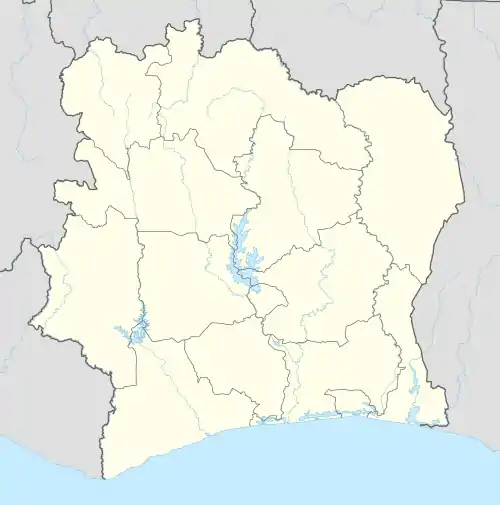
Source: Jane's World Armies Issue 23 – 2008
Numbers in brackets indicate parent military regions.
Note: French forces of battalion strength[12] are stationed near Abidjan, as well as over 7,000 troops under U.N. command. In 2011, rebel forces overran the country during the Second Ivorian Civil War.
The Ivorian army had three infantry battalions, an armoured battalion, an artillery battery, and seven specialist companies in 1993.[13] The effective strength of the army was about 3,000 troops for the first ten years of Ivorian independence, increasing to over 8,000 in the mid-1980s before declining steadily to about 5,500.[2] It has always remained the largest branch of the armed forces.[14]
In 1987, the army was responsible for the country's five military regions, each of which was supervised by a colonel.[2] The First Military Region controlled the concentration of forces in and around Abidjan, its principal units there being a rapid intervention battalion (airborne), an infantry battalion, an armored battalion, and an air defense artillery battalion. The Second Military Region was located in Daloa and comprised one infantry battalion.[2] The Third Military Region was headquartered in Bouaké and was home to an artillery, an infantry, and an engineer battalion.[2] The Fourth Military Region maintained only a Territorial Defense Company headquartered in Korhogo The Fifth Military Region was formerly known as the Western Operational Zone, a temporary command created to respond to the security threat caused by the First Liberian Civil War.[2]
By 2010, the system of military regions had been abolished.[14]
As of July 2011, General Soumaïla Bakayoko is the chief of staff of the army, and colonel-major Gervais Kouakou Kouassi is the Chief of the Gendarmerie.[15]
As of October 2011, previously active units around Abidjan reportedly included the:[16]
- 1st Infantry Battalion – (1er Bataillon d'infanterie des forces armées terrestres ivoiriennes), at Akouédo (new camp)
- Armoured Battalion – (Battaillon Blinde), at Akouédo (new camp). The new camp at Akouedo had reportedly been almost completely destroyed. Akouedo appears to be at 5' 21 7 N, 3' 26 30 W.
- 1st Parachute Commando Battalion – 1er Bataillon des Commandos Parachutistes (1er BCP), old camp at Akouedo, on the route to the village Ébrié.
The 2nd Infantry Battalion appears to have been based at Daloa for some time. A 2003 change of command ushered in the 16th commander of the unit,[17] and there are also reports from 2009 and 2011.
Reported special forces units include:
- Group des Forces Speciales (GFS)
- Fusiliers Commandos d Air (FUSCOA)
- Détachement d' Intervention Rapide
- Fusiliers Marins Commandos (FUMACO/ naval commandos)
Current army equipment
The Ivorian army has traditionally been equipped with French weapons, most of which were delivered in the 1980s under generous military grants from Paris.[2] During Laurent Ghagbo's administration, large quantities of second-hand Soviet arms were acquired from Angola, Ukraine, and Belarus.[4]
Small arms
Anti-tank weapons
| Name | Image | Type | Origin | Caliber | Notes |
|---|---|---|---|---|---|
| M40A1 | 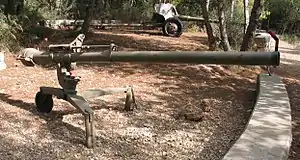 |
Recoilless rifle | 106mm | 12 in service.[28] |
Tanks
| Name | Image | Type | Origin | Quantity | Status | Notes |
|---|---|---|---|---|---|---|
| T-55 |  |
Medium tank | 10[29] | INS |
Scout cars
| Name | Image | Type | Origin | Quantity | Status | Notes |
|---|---|---|---|---|---|---|
| BRDM-2 | _owned_by_James_Stewart_pic7.JPG.webp) |
Scout car | 13[29] | INS | ||
| Caiman | .jpg.webp) |
Scout car | 8[29] | INS |
Infantry fighting vehicles
| Name | Image | Type | Origin | Quantity | Status | Notes |
|---|---|---|---|---|---|---|
| BMP-1 |  |
Infantry fighting vehicle | 10[29] | INS | ||
| BMP-2 |  |
Infantry fighting vehicle | INS |
Armored personnel carriers
| Name | Image | Type | Origin | Quantity | Status | Notes |
|---|---|---|---|---|---|---|
| BTR-80 | 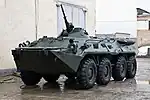 |
Amphibious Armored personnel carrier | 6[29] | INS | ||
| AT105 Saxon | 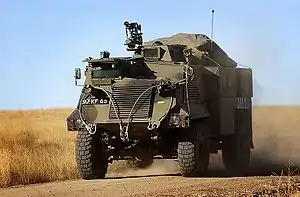 |
Armored personnel carrier | 4[30] | INS | ||
| Panhard M3 |  |
Armoured personnel carrier | 12[29] | INS | ||
| VAB |  |
Armored personnel carrier | 13[29] | INS | ||
| ACMAT Bastion |  |
Armoured personnel carrier | 9[29] | INS | ||
| Mamba | .jpg.webp) |
Armoured personnel carrier | 10[30] | INS | ||
| Otokar Cobra |  |
Infantry mobility vehicle | 20+[31] | INS |
Reconnaissance
| Name | Image | Type | Origin | Quantity | Status | Notes |
|---|---|---|---|---|---|---|
| ERC-90 Sagaie | 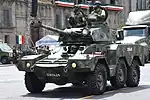 |
Armored car | 7[30] | INS | ||
| Panhard AML |  |
Armored car | 20[30] | INS |
Utility vehicles
| Name | Image | Type | Origin | Quantity | Status | Notes |
|---|---|---|---|---|---|---|
| ACMAT ALTV | 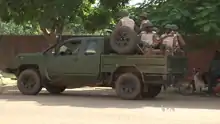 |
Tactical vehicle | Unknown[32] | INS |
Artillery
| Name | Image | Type | Origin | Quantity | Status | Notes |
|---|---|---|---|---|---|---|
| Rocket artillery | ||||||
| BM-21 Grad | .jpg.webp) |
Multiple rocket launcher | 6[29] | INS | ||
| Field artillery | ||||||
| M1950 | 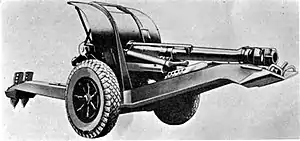 |
Howitzer | 4[29] | INS | ||
| Mortars | ||||||
| BM-37 |  |
Mortar | 10[29] | INS | ||
| 2B11 | 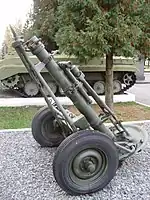 |
Mortar | 10[30] | INS | ||
Towed anti-aircraft guns
| Name | Image | Type | Origin | Quantity | Status | Notes |
|---|---|---|---|---|---|---|
| ZU-23-2 |  |
Autocannon | 10[29] | INS | ||
| Bofors L/60 | 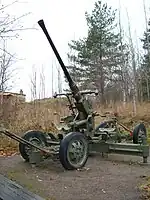 |
Autocannon | 5[29] | INS |
Man-portable air-defense systems
| Name | Image | Type | Origin | Quantity | Status | Notes |
|---|---|---|---|---|---|---|
| 9K32 Strela-2[29] | MANPADS | INS |
Air Force

After achieving independence from France in 1960, Ivory Coast maintained strong links with France through bilateral defence agreements.[33] French training and operating techniques has been used since the establishment of the air force. The first equipment supplied included three Douglas C-47's and seven MH.1521 Broussard STOL utility aircraft in 1961. The first jet aircraft to enter service in October 1980 were six Alpha Jet CI light attack and advanced training aircraft; six more were ordered, but were subsequently cancelled. However, another was purchased in 1983.
The 1979 air force had only transport and liaison aircraft. In 1987, the Library of Congress Country Study said that the Air Force's official name, Ivoirian Air Transport and Liaison Group (Groupement Aérien de Transport et de Liaison—GATL), 'reflects an original mission focused more on logistics and transport rather than a combat force.'
In 2004, following an air strikes on French peacekeepers by Ivorian forces, the French military destroyed all aircraft in the Air Force of Ivory Coast. Gbagbo had ordered air strikes on Ivorian rebels. On 6 November 2004, at least one Ivorian Sukhoi Su-25 bomber attacked a French peacekeeping position in the rebel town of Bouaké at 1 pm, killing nine French soldiers and wounding 31.[34] An American development worker, reported to have been a missionary, was also killed. The Ivorian government claimed the attack on the French was unintentional, but the French insisted that the attack had been deliberate.[35]
Several hours after the attack,French President Jacques Chirac ordered the destruction of the Ivorian air force and the seizure of Yamoussoukro airport. The French military performed an overland attack on the airport, destroying two Sukhoi Su-25 ground attack aircraft and three Mi-24 helicopter gunships.[36] Two more military helicopters were destroyed during combat in the skies over Abidjan. France then flew in 300 troops and put three Dassault Mirage F1 jet fighters based in nearby Gabon on standby.[35]
Since then, the Air Force of Ivory Coast has been rebuilt.[36] In 2007, Aviation Week & Space Technology reported a total of six aircraft in service: one Antonov An-32 tactical transport, one Cessna 421 Golden Eagle utility aircraft, two Eurocopter SA 365 Dauphin helicopters, one Gulfstream IV VIP aircraft, and one Mil Mi-24 attack helicopter.[37] It is unknown whether any of these aircraft were truly operational. In addition, Deagel.com reported two Mikoyan-Gurevich MiG-23 attack aircraft.[38]
Aircraft

| Aircraft | Origin | Type | Variant | In service | Notes | |
|---|---|---|---|---|---|---|
| Reconnaissance | ||||||
| King Air | United States | reconnaissance | 90 | 1[39] | ||
| Transport | ||||||
| Boeing 727 | United States | VIP transport | 1[40] | Acquired in 2011 | ||
| CASA C-295 | Spain | transport | 1[39] | |||
| Gulfstream IV | United States | VIP transport | 1[41] | |||
| Antonov An-26 | Soviet Union | transport | 2[39] | |||
| Beechcraft 1900 | United States | transport | 1900D | 1[39] | ||
| Helicopters | ||||||
| Mil Mi-24 | Soviet Union | attack | Mi-24/35 | 1[39] | ||
| Agusta Westland AW139 | Italy | VIP transport | 1[42] | |||
| UAV | ||||||
| Delair DT26 | France | surveillance | 4[31] | |||
Navy
Ivory Coast has a brown-water navy whose mission is coastal surveillance and security for the nation's 340-mile coastline.[14] The operational capability of the navy was severely degraded due to the diversion of resources to the army and air force during the civil wars, and it remains incapable of conducting operations beyond the general vicinity of Abidjan.[14] In 2014 they received three coastal defence vessels, and place an order for 30 inflatable boats and 10 patrol craft in 2018 from the Raidco Marine shipbuilders[43][44]
| Vessel Name | Origin | Builder | Type | In service | Notes |
|---|---|---|---|---|---|
| L'intrepide | France | Patra Large patrol craft | 1978 | ||
| L'élephant | France | DCN Brest | Batral-E Type LSM landing craft | 1977 |
Retired
Early vessels were a second hand submarine chaser (SC 1337) from the United States, and three former French Navy boats (one patrol craft, with two fast attack boats[45][46]
International forces
A mutual defense accord signed with France in April 1961 provides for the stationing of French Armed Forces troops in Ivory Coast.[47] The 43rd Marine Infantry Battalion of the French Army's Troupes de Marine (43e bataillon d'infanterie de marine) was based in Port Bouet adjacent to the Abidjan Airport from 1979 and had more than 500 troops assigned until 2011, when it appears to have been disbanded. The French military also maintains a force as part of Opération Licorne.
From summer 2011, Operation Licorne, the French force, previously over 5,000 strong, is roughly 700, and consists of Licorne headquarters, Battalion Licorne (BATLIC), seemingly made up of elements of the 2nd Marine Infantry Regiment and the Régiment d'infanterie-chars de marine, and a helicopter detachment.[12]
The United Nations has maintained the peacekeeping mission ONUCI in the country since 2004. On 28 February 2011 ONUCI consisted of 7,568 troops, 177 military observers, and numerous international civilians and Police; the mission had received helicopter and infantry reinforcement from UNMIL during the stand-off since the late 2010 elections which had been won by Alassane Ouattara.[48]
National Gendarmerie
Since independence, the Ivory Coast has maintained a paramilitary gendarmerie force with a mandate to assist the police with law enforcement duties in the country's rural districts.[14] However, it may also be deployed alongside the army to quell internal unrest.[14] For a number of decades, the size of the Ivorian National Gendarmerie remained consistent at around 4,000 to 5,000 personnel, supervised by a commandant.[13] It underwent a massive expansion following the outbreak of the First Ivorian Civil War, increasing to about 12,000 personnel commanded by a major general.[14] Gendarmes undergo training as cadets at a National Gendarmerie Academy.[2]
The National Gendarmerie maintains an investigative branch, the Brigades de Recherches, which has been accused of various human rights abuses, including extrajudicial killings and unlawful detention.[49]
References
- "Ivory Coast 'deal' with rebel soldiers". BBC News. May 15, 2017. Retrieved May 25, 2020.
- Handloff, Robert, ed. (1988). Cote d'Ivoire, a Country Study. Area Handbook Series (Third ed.). Washington, D.C.: Department of the Army, American University. pp. 184–201. ISBN 978-0160309786.
- Charbonneau, Bruno (2008). France and the New Imperialism: Security Policy in Sub-Saharan Africa. Abingdon: Routledge. pp. 60–61. ISBN 978-0754672852.
- "Trade Registers". Armstrade.sipri.org. Retrieved 2013-06-20.
- N'Diaye, Boubacar (1997). The Challenge of Institutionalizing Civilian Control: Botswana, Ivory Coast, and Kenya in comparative perspective. Lanham: Lexington Books. pp. 159–161. ISBN 978-0739102398.
- Ayittey, George (2005). Africa Unchained: The Blueprint for Africa's Future. Basingstoke: Palgrave-Macmillan. pp. 444–445. ISBN 978-1403973863.
- Brauer, Jurgen; Goldsmith, Benjamin (2010). Economics of War and Peace: Economic, Legal and Political Perspectives. Bingley: Emerald Group Publishing Limited. pp. 81–82. ISBN 978-0857240040.
- Rimanelli, Marco (2008). Historical Dictionary of NATO and Other International Security Organizations. Lanham: Scarecrow Press. pp. 617–618. ISBN 978-0810853294.
- Besada, Hany (2009). From Civil Strife to Peace Building: Examining Private Sector Involvement in West African Reconstruction. Waterloo, Ontario: Wilfrid Laurier University Press. p. 75. ISBN 978-1554580521.
- Amoah, Michael (2011). Nationalism, Globalization, and Africa. Basingstoke: Palgrave-Macmillan. pp. 94–95. ISBN 978-1-137-00216-7.
- "Ivory Coast minister freed after troops mutiny deal". Al Jazeera. Doha, Qatar. 7 January 2017. Archived from the original on January 28, 2017. Retrieved 23 January 2017.
- (in French) French Ministry of Defence, Les forces françaises en Côte d'Ivoire, 28 September 2011, accessed November 2011
- Bonsignore, Ezio, ed. (1993). World Defence Almanac 1992-93: The Balance of Military Power. Bonn: Monch Publishing Group. pp. 169–170. ISSN 0722-3226.
- Sheehan, Patricia; Ong, Jacqueline (2010). Cultures of the world: Côte D'Ivoire. New York: Cavendish Square Publishing. pp. 34–35. ISBN 978-0761448549.
- "Armée ivoirienne / De Frci à Fanci : ce qui change". Abidjan.net. Retrieved May 25, 2020.
- "Armée ivoirienne: Le camp du 1er Bataillon d'infanterie à Akouédo (nouveau) n'existe plus". October 28, 2011.
- http://www.news225.net/201604.html Archived 2016-03-04 at the Wayback Machine, accessed 2011
- Jones, Richard D. Jane's Infantry Weapons 2009/2010. Jane's Information Group; 35 edition (January 27, 2009). ISBN 978-0-7106-2869-5.
- Anders, Holger (June 2014). Identifier les sources d'approvisionnement: Les munitions de petit calibre en Côte d'Ivoire (PDF) (in French). Small Arms Survey and United Nations Operation in Côte d'Ivoire. p. 15. ISBN 978-2-940-548-05-7. Archived from the original (PDF) on 2018-10-09. Retrieved 2018-09-05.
- Le Goff, Hervé (September 2007). "Les MAB P.8 et P.15 "Combat"". Gazette des Armes (in French). No. 390. p. 57.
- Hogg, Ian (1989). Jane's Infantry Weapons 1989-90, 15th Edition. Jane's Information Group. pp. 826–836. ISBN 0-7106-0889-6.
- de Tessières, Savannah (April 2012). Enquête nationale sur les armes légères et de petit calibre en Côte d'Ivoire: les défis du contrôle des armes et de la lutte contre la violence armée avant la crise post-électorale (PDF) (Report). Special Report No. 14 (in French). UNDP, Commission Nationale de Lutte contre la Prolifération et la Circulation Illicite des Armes Légères et de Petit Calibre and Small Arms Survey. Archived from the original (PDF) on 2018-10-09. Retrieved 2018-08-30.
- Bonn International Center for Conversion; Bundeswehr Verification Center. "Type 81". SALW Guide: Global distribution and visual identification. Archived from the original on 31 August 2018. Retrieved 31 August 2018.
- Binnie, Jeremy; de Cherisey, Erwan (2017). "New-model African armies" (PDF). Jane's. Archived from the original (PDF) on 22 June 2017.
- "Post-WWII use of the MAS-36 rifle: Part II (export users)". wwiiafterwwii.wordpress.com. 2015-08-23. Retrieved 2017-06-15.
- Gander, Terry J.; Cutshaw, Charles Q., eds. (2001). Jane's Infantry Weapons 2001/2002 (27th ed.). Coulsdon: Jane's Information Group. ISBN 9780710623171.
- Shea, Dan (February 2010). "LRAC F1: 89mm Shoulder Fired Launcher". Small Arms Review. Vol. 13, no. 5. Archived from the original on 2019-10-18. Retrieved 2018-12-12.
- Military Balance 2016, p. 439.
- International Institute for Strategic Studies (2021). The Military Balance. p. 459. ISBN 9781032012278.
- "Trade Registers". armstrade.sipri.org.
- "Cote d'Ivoire reveals new armoured vehicles". Defenceweb. 10 August 2022. Retrieved 13 August 2022.
- Lagneau, Laurent (13 September 2012). "ACMAT décroche une importante commande de véhicules militaires légers en Côte d'Ivoire". opex360.com (in French).
- World Aircraft Information Files. Brightstar Publishing, London. File 338 Sheet 02
- "Ivory Coast seethes after attack", BBC News, 7 November 2004.
- Ann Talbot, "Ivory Coast: protests erupt vs. French military strikes", World Socialist Web Site, 9 November 2004.
- "Ivory Coast seethes after attack". BBC News. 2004-11-04. Retrieved 2007-10-10.
- "World Military Aircraft Inventory", Aerospace Source Book 2007, Aviation Week & Space Technology, January 15, 2007.
- "Search results for Bulgaria". www.deagel.com. Retrieved May 25, 2020.
- "World Air Forces 2023". Flightglobal Insight. 2023. Retrieved 24 December 2022.
- "Republique de Cote d'Ivoire TU-VAO". airframes.org. Retrieved 21 March 2015.
- "Gulfstream IV TU-VAD". planelogger.com. Retrieved 14 October 2019.
- "Ivory Coast receiving AW139 VIP helicopter". defenceWeb. 2015. Retrieved 31 August 2017.
- "Exchange officer from the Ivory Coast Navy gains a new RCN family". Archived from the original on 2019-01-19. Retrieved 2019-01-18.
- "Ivory Coast rebuilds navy to ward off growing piracy threat". Reuters. Jan 28, 2014. Retrieved May 25, 2020 – via www.reuters.com.
- "Ivory Coast Navy". Retrieved May 25, 2020.
- "World Navies Today: Other African Navies". www.hazegray.org. Retrieved May 25, 2020.
- Boubacar N'Diaye, 'Ivory Coast's Civilian Control Strategies 1961–68: A Critical Assessment,' Journal of Political and Military Sociology Special Issue on West Africa, Vol. 28, No. 2, Winter 2000, p.253
- See United Nations Security Council Resolution 1967 and United Nations Security Council Resolution 1968
- "Human Rights Watch: Cote d'Ivoire" (PDF). New York: Human Rights Watch. November 2002. Archived from the original (PDF) on June 24, 2013. Retrieved 20 September 2016.
Works cited
- International Institute for Strategic Studies (February 2016). The Military Balance 2016. Vol. 116. Routlegde. ISBN 978-1-85743-835-2.
Further reading
- Cote d'Ivoire - Security Information
- 'Old Rivalries stall Côte d'Ivoire army merger,' Jane's Defence Weekly, 12 November 2008, p. 23
- Arthur Boutellis, The Security Sector in Côte d'Ivoire: A Source of Conflict and a Key to Peace, International Peace Institute, Policy Papers – May 26, 2011
- Clayton, Anthony (1988). France, Soldiers and Africa. Washington: Brassey's Inc. ISBN 978-0-08-034748-6.
- Clayton, Anthony (1994). Histoire de l'Armée française en Afrique 1830-1962 (in French). Paris: Albin Michel. ISBN 978-2-28-600869-7.
- Aline Leboeuf, "La réforme du secteur de sécurité à l'ivoirienne", March 2016 (French), accessible at La réforme du secteur de sécurité à l'ivoirienne
- Raphaël Outtara, 'Côte d'Ivoire,' in Alan Bryden, Boubacar N'Diaye and 'Funmi Olonisakin (Eds.), Challenges of Security Sector Governance in West Africa, Geneva Centre for the Democratic Control of Armed Forces/Lit Verlag, June 2008, pp 75–92
- Raphaël Outtara, 'Côte d'Ivoire,' in Alan Bryden, Boubacar N'Diaye, 'Security Sector Governance in Francophone West Africa: Realities and Opportunities,' DCAF/Lit Verlag, 2011.
- Savannah de Tessieres, 'Reforming the Ranks: Public Security in a Divided Côte d'Ivoire,' in Small Arms Survey 2011: States of Security, Small Arms Survey/Graduate Institute of International and Development Studies Geneva, Cambridge University Press, 2011
- Cooper, Tom & Weinert, Peter (2010). African MiGs: Volume I: Angola to Ivory Coast. Harpia Publishing LLC. ISBN 978-0-9825539-5-4.


















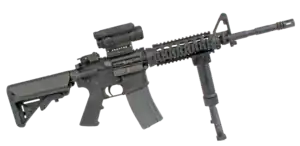


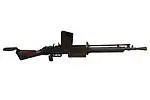






.jpg.webp)


